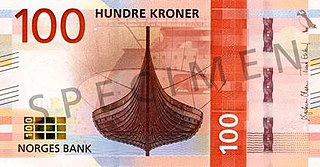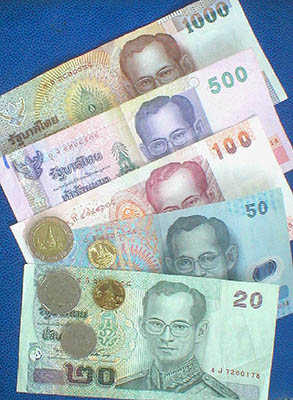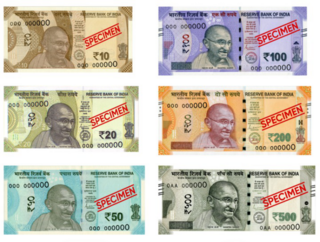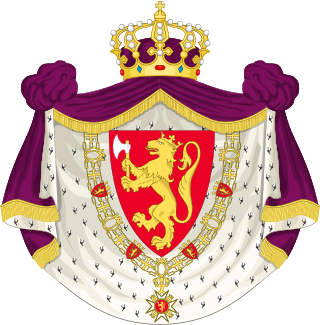
The krona is the currency of the Kingdom of Sweden. It is one of the currencies of the European Union. Both the ISO code "SEK" and currency sign "kr" are in common use for the krona; the former precedes or follows the value, the latter usually follows it but, especially in the past, it sometimes preceded the value. In English, the currency is sometimes referred to as the Swedish crown, as krona means "crown" in Swedish. The Swedish krona was the ninth-most traded currency in the world by value in April 2016.
There are eight euro coin denominations, ranging from one cent to two euros. The coins first came into use in 2002. They have a common reverse, portraying a map of Europe, but each country in the eurozone has its own design on the obverse, which means that each coin has a variety of different designs in circulation at once. Four European microstates that are not members of the European Union use the euro as their currency and also have the right to mint coins with their own designs on the obverse side.

The krone, plural kroner, is the currency of the Kingdom of Norway. It was traditionally known as the Norwegian crown in English; however, this has fallen out of common usage. It is nominally subdivided into 100 øre, although the last coins denominated in øre were withdrawn in 2012.

The Australian dollar is the official currency and legal tender of Australia, including all of its external territories, and three independent sovereign Pacific Island states: Kiribati, Nauru, and Tuvalu. In April 2022, it was the sixth most-traded currency in the foreign exchange market and as of Q4 2023 the seventh most-held reserve currency in global reserves.

The baht is the official currency of Thailand. It is divided into 100 satang. Prior to decimalisation, the baht was divided into eight fueang, each of eight at. The issuance of currency is the responsibility of the Bank of Thailand. SWIFT ranked the Thai baht as the 10th-most-frequently used world payment currency as of December 2023.

The Canadian dollar is the currency of Canada. It is abbreviated with the dollar sign $. There is no standard disambiguating form, but the abbreviations Can$, CA$ and C$ are frequently used for distinction from other dollar-denominated currencies. It is divided into 100 cents (¢).

Kongsberg is a historical mining town and municipality in Buskerud county, Norway. The city is located on the river Numedalslågen at the entrance to the valley of Numedal. Kongsberg has been a centre of silver mining, arms production and forestry for centuries, and is the site of high technology industry including the headquarters of Norway's largest defence contractor Kongsberg Gruppen.

The sovereign is a British gold coin with a nominal value of one pound sterling (£1) and contains 0.2354 troy oz of pure gold. Struck since 1817, it was originally a circulating coin that was accepted in Britain and elsewhere in the world; it is now a bullion coin and is sometimes mounted in jewellery. In addition, circulation strikes and proof examples are often collected for their numismatic value. In most recent years, it has borne the design of Saint George and the Dragon on the reverse; the initials of the designer, Benedetto Pistrucci, are visible to the right of the date.

The Royal Mint is the United Kingdom's official maker of British coins. It is currently located in Llantrisant, Wales, where it moved in 1968.

The Royal Canadian Mint is the mint of Canada and a Crown corporation, operating under the Royal Canadian Mint Act. The shares of the mint are held in trust for the Crown in right of Canada.

The Indian rupee is the official currency in India. The rupee is subdivided into 100 paise. The issuance of the currency is controlled by the Reserve Bank of India. The Reserve Bank manages currency in India and derives its role in currency management based on the Reserve Bank of India Act, 1934.

The coat of arms of Norway is the arms of dominion of King Harald V of Norway, and as such represents both the monarch and the kingdom. It depicts a standing golden lion on a red background, bearing a golden crown and axe with silver blade.

The rigsdaler specie was a unit of silver currency used in Norway from 1544, renamed as the speciedaler in 1816 and used until 1873. Norway used a common reichsthaler currency system shared with Denmark, Hamburg and Schleswig-Holstein until 1873 when the gold standard was implemented in Scandinavia and the German Empire.

Myntverket is a private Swedish company that produces coins and medals, including the Swedish national coins and the Nobel Prize medals. As of 2008, Swedish coins are minted by Myntverket's parent company, Mint of Finland Ltd in Helsinki, Finland, ending a 1,012-year history of minting Swedish coins in Sweden.
Samlerhuset Norge is a Norwegian distributor of collectibles, mainly coins and medals, but also stamps, banknotes and philatelic numismatic covers (PNC). Samlerhuset is located in Oppegård, Norway. The company, with the full name Samlerhuset Norge, is part of the Samlerhuset Group B.V., headquartered in Almere, the Netherlands. Samlerhuset was founded in Norway in 1994, and started expanding to several countries in Europe and to China. Samlerhuset Group B.V. now have offices in 16 countries. They cooperate with a number of central banks on commemorative coins and coin collections.

The Brazilian real is the official currency of Brazil. It is subdivided into 100 centavos. The Central Bank of Brazil is the central bank and the issuing authority. The real replaced the cruzeiro real in 1994.

The Royal Mint of Denmark is a mint established by the Danish monarchy in the early 16th century, which currently by law is the only company allowed to mint the Danish currency (DKK). It is owned by the Danish State and administered as a subsidiary of the Danish Central Bank.

The Mint of Finland, legally registered as Suomen Rahapaja Oy, is the national mint of Finland. It was established by Alexander II of Russia in 1860 as the mark became the official currency of the Grand Duchy of Finland. The mint was first located in the Katajanokka district of Helsinki and in 1988 the new production facility was opened in Vantaa. Mint of Finland has been a public limited company since 1993. Today it is the owner of the Swedish mint, the Myntverket, and owns half of the shares of the Royal Norwegian Mint.
















